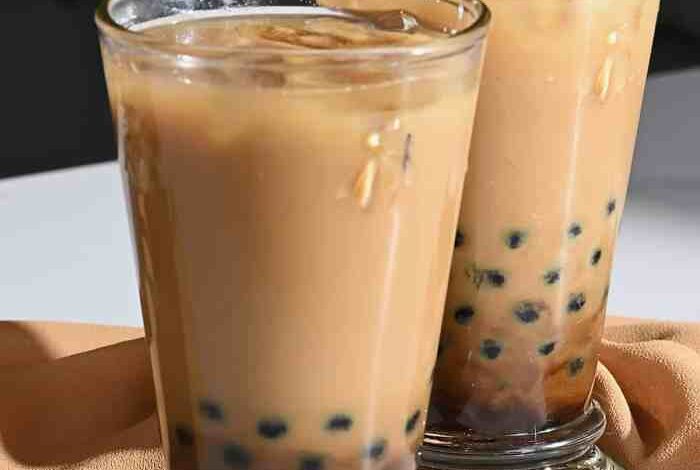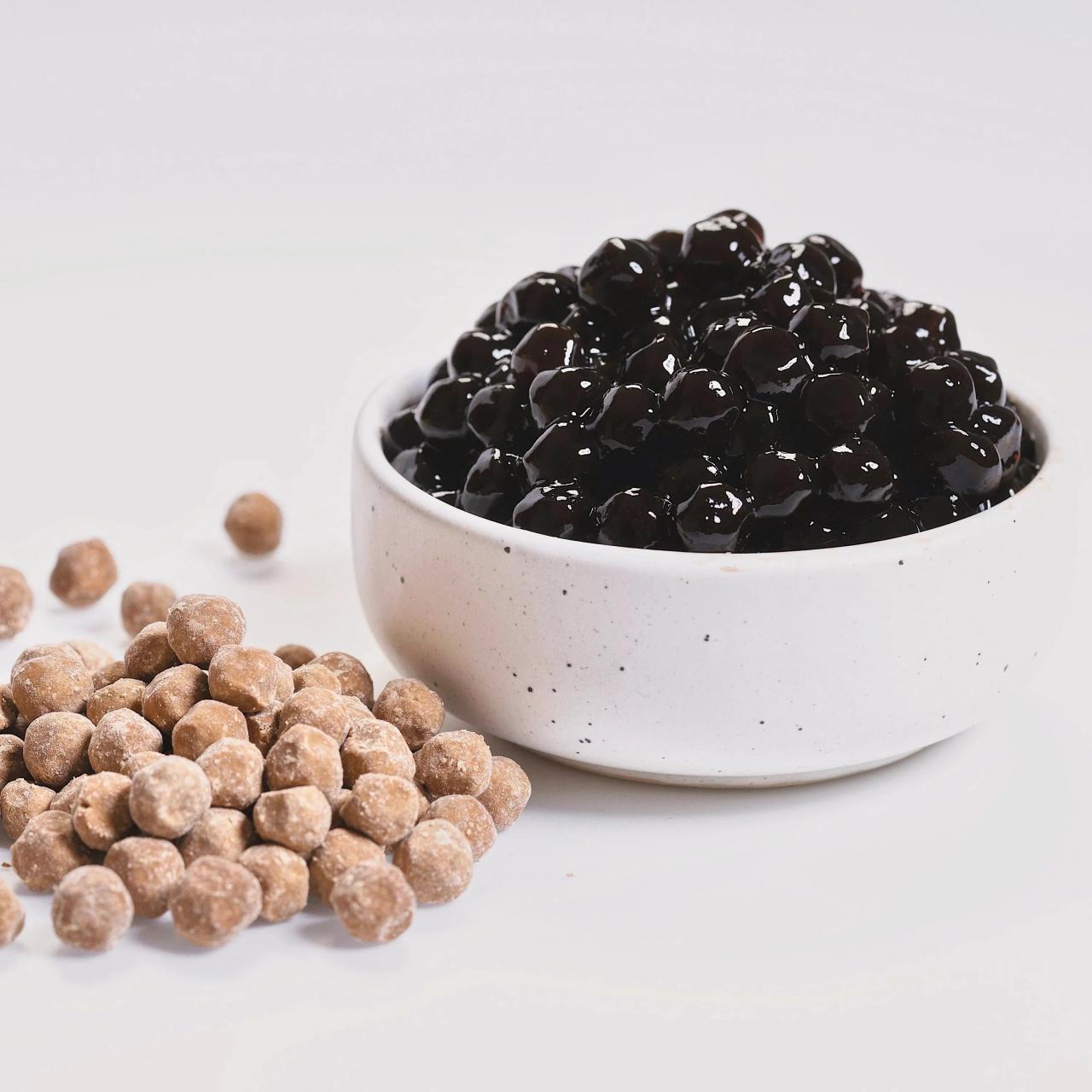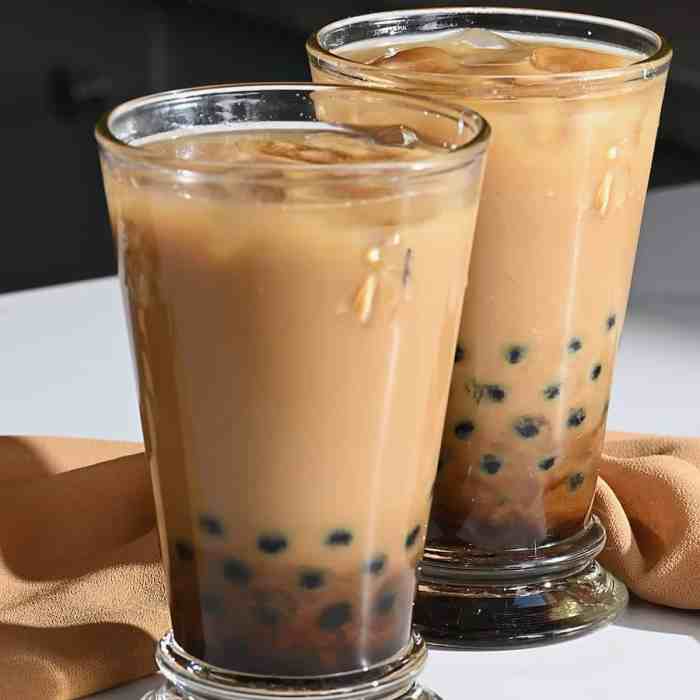
Boba Coconut Milk Black Tea with Tapioca Pearls: A Creamy, Chewy Delight
Boba coconut milk black tea with tapioca pearls is a delightful fusion of flavors and textures, offering a refreshing twist on the classic boba tea experience. This unique beverage combines the creamy richness of coconut milk with the bold, earthy notes of black tea, all balanced by the chewy delight of tapioca pearls.
The result is a symphony of taste that tantalizes your senses and leaves you craving more.
This article will explore the origins and cultural significance of boba tea, delve into the unique qualities of coconut milk, black tea, and tapioca pearls, and provide a glimpse into the diverse world of boba tea flavors and trends. We’ll also discuss the nutritional aspects of this popular drink and offer tips for enjoying it in a healthy way.
Boba Tea Culture and Trends

Boba tea, also known as bubble tea, has become a global phenomenon, captivating taste buds and inspiring a vibrant culture around its unique combination of flavors and textures. Its journey from a humble Taiwanese street food to a beloved beverage enjoyed worldwide is a testament to its versatility and the power of social media in spreading trends.
Let’s explore the fascinating evolution of boba tea, its cultural impact, and the exciting innovations that continue to shape the boba tea landscape.
Timeline of Boba Tea Trends
The history of boba tea is a fascinating journey, marked by the evolution of flavors, ingredients, and the rise of boba tea shops.
- 1980s: Birth of Boba Tea– Boba tea originated in Taiwan in the 1980s. The exact origin story is debated, but it is generally credited to a tea shop owner named Liu Han-chieh who combined tapioca pearls with iced tea. The initial flavors were simple, focusing on black tea and milk tea with tapioca pearls.
- 1990s: Expansion and Experimentation– Boba tea began to gain popularity in Taiwan and spread to other parts of Asia in the 1990s. Experimentation with flavors and ingredients took off, introducing fruity flavors like mango and strawberry, as well as additions like popping boba and jellies.
- 2000s: Global Phenomenon– The 2000s saw boba tea’s global expansion. It became popular in North America, Europe, and Australia, with dedicated boba tea shops popping up in major cities. The introduction of new flavors like taro, matcha, and brown sugar milk tea further fueled its popularity.
- 2010s-Present: Innovation and Customization– The 2010s witnessed a surge in boba tea innovation. New flavors, toppings, and variations emerged, catering to diverse tastes. The rise of social media has also played a crucial role in promoting boba tea trends and fueling the demand for unique and Instagrammable creations.
Rise of Boba Tea Shops
The rise of boba tea shops has been a significant factor in the beverage industry’s evolution. These shops have become hubs for social gatherings, offering a variety of flavors and customizations to satisfy diverse palates.
- Growth and Competition– The global popularity of boba tea has led to a surge in the number of boba tea shops worldwide. This has created a highly competitive market, with shops vying for customers by offering innovative flavors, unique toppings, and appealing store designs.
- Impact on the Beverage Industry– The rise of boba tea has introduced a new category of beverages, challenging the traditional coffee and juice markets. The demand for boba tea has also driven innovation in the production of tapioca pearls and other boba tea ingredients.
Innovative Boba Tea Creations
Boba tea shops are constantly pushing the boundaries of flavor and creativity, introducing innovative creations that capture the imagination of boba tea enthusiasts.
- Unique Flavor Combinations– Boba tea shops are experimenting with unexpected flavor combinations, blending traditional tea flavors with exotic fruits, spices, and even savory elements. Examples include matcha with red bean, black sesame with taro, and lavender with honey.
- Creative Toppings– Toppings are an integral part of the boba tea experience, and shops are constantly adding new and exciting options. Beyond the classic tapioca pearls, popular choices include popping boba, jellies, puddings, and even cheese foam.
- Aesthetically Pleasing Presentations– The visual appeal of boba tea is equally important, and shops are focusing on creating aesthetically pleasing presentations. Gradients, layered toppings, and artistic designs are used to elevate the boba tea experience.
Boba Tea Experience: Boba Coconut Milk Black Tea With Tapioca Pearls

The boba tea experience is a multi-sensory journey that engages all your senses, from the initial visual appeal to the final satisfying chew of the tapioca pearls. This delightful beverage offers a symphony of flavors, textures, and colors, making it a truly unique and enjoyable experience.
Visual Appeal
Boba tea is a feast for the eyes, with its vibrant colors and playful textures. The tea itself can range from a deep amber to a bright green, depending on the type of tea used. The coconut milk adds a creamy white hue, while the tapioca pearls provide a contrasting black or brown element.
The combination of these colors creates a visually appealing and inviting drink. The presentation of boba tea also adds to its visual appeal. The beverage is often served in clear plastic cups, allowing the colorful layers to be seen.
The addition of toppings like popping boba, jellies, or fruit pieces further enhances the visual appeal of the drink.
Aroma and Flavor Profile
The aroma of boba tea is a captivating blend of sweet and savory notes. The black tea provides a grounding base, while the coconut milk adds a rich, creamy fragrance. The tapioca pearls contribute a subtle sweetness and a hint of starchiness.
This complex aroma tantalizes the senses and creates a sense of anticipation for the taste to come.The flavor profile of boba tea is equally enticing. The black tea provides a slightly bitter and astringent taste, which is balanced by the sweetness of the coconut milk.
The tapioca pearls add a chewy texture and a mild sweetness that complements the overall flavor profile. The combination of these flavors creates a harmonious and satisfying taste experience.
Tactile Sensation, Boba coconut milk black tea with tapioca pearls
The tactile sensation of chewing tapioca pearls is an integral part of the boba tea experience. The pearls are soft and chewy, providing a pleasant contrast to the smooth texture of the tea and coconut milk. The act of chewing the pearls adds a playful element to the experience, making it more interactive and enjoyable.
The tapioca pearls also contribute to the overall mouthfeel of the boba tea. The chewiness of the pearls helps to balance the creaminess of the coconut milk and the smoothness of the tea. This interplay of textures creates a more complex and satisfying drinking experience.

